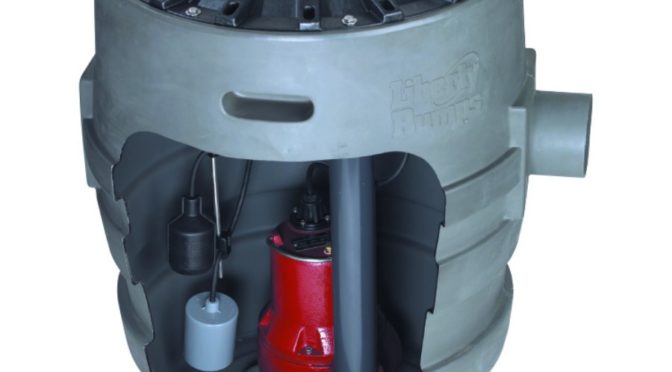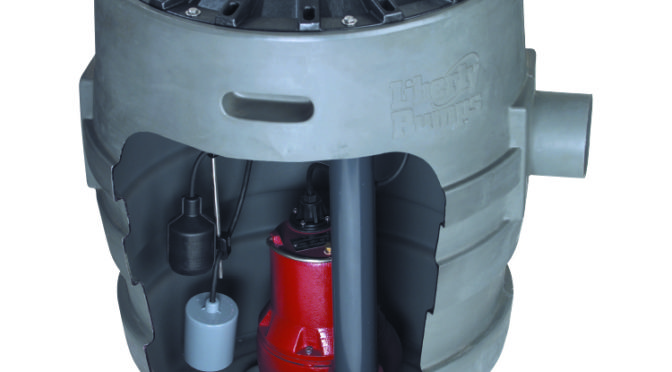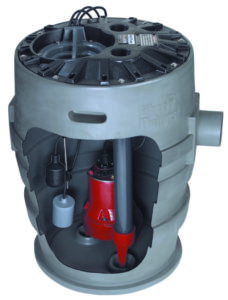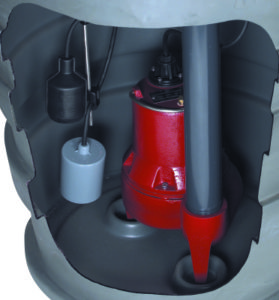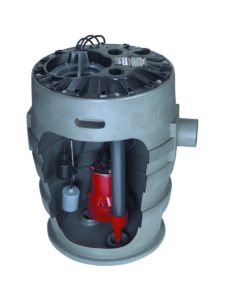 If you’ve got sewage wastewater draining from a sewage system installed below grade, you’re not going to be able to take advantage of gravity, and will need a sewage pump to get it out of your home or business. As a homeowner, landlord, or small business owner, you might be tempted to try to get by with the cheapest sewage pump possible and the cheapest installation you find. But we’d recommend spending a bit more in order to get the job right, because the peace of mind from several years of reliability will be worth more in the end than saving a few dollars on an unreliable pump that breaks down right after the warranty ends. So what’s a good sewage system?
If you’ve got sewage wastewater draining from a sewage system installed below grade, you’re not going to be able to take advantage of gravity, and will need a sewage pump to get it out of your home or business. As a homeowner, landlord, or small business owner, you might be tempted to try to get by with the cheapest sewage pump possible and the cheapest installation you find. But we’d recommend spending a bit more in order to get the job right, because the peace of mind from several years of reliability will be worth more in the end than saving a few dollars on an unreliable pump that breaks down right after the warranty ends. So what’s a good sewage system?
If you need to grind through tough solids, you need a sewage grinder pump, and the best you’re going to find under a grand is the Liberty Pumps PRG101A. If you only need a sewage ejector pump but want it a pre-installed, highly reliable package, we’d highly recommend the Liberty Pumps P372LE51. But what if you don’t need quite as much pumping or lifting power? This is where the Liberty Pumps P372LE41 Sewage Pump System comes in. However, we generally wouldn’t recommend it over the P372LE51 unless you truly can’t spend any more to get the 51. Our full review and comparison is below, and you can buy it here.
Key Features of the Liberty Pumps P372LE41 Simplex Sewage System (60 Second Summary)
 The Liberty Pumps P372LE41 is a pre-assembled residential sewage ejector package that can also work in light commercial settings. It uses the LE41A sewage pump and features a 4/10 horsepower electric motor throttled down to a maximum water flow of 7,680 gallons per hour (124 gallons per minute) and a total head of 19 feet. Backed by a 3 year Liberty Pumps warranty, the pump is 30 inches tall, 20-1/4 inches in diameter at the base, and 24-1/2 inches at its widest diameter. It weighs 60 pounds completely assembled.
The Liberty Pumps P372LE41 is a pre-assembled residential sewage ejector package that can also work in light commercial settings. It uses the LE41A sewage pump and features a 4/10 horsepower electric motor throttled down to a maximum water flow of 7,680 gallons per hour (124 gallons per minute) and a total head of 19 feet. Backed by a 3 year Liberty Pumps warranty, the pump is 30 inches tall, 20-1/4 inches in diameter at the base, and 24-1/2 inches at its widest diameter. It weighs 60 pounds completely assembled.
The P372LE41 can pass spherical solids up to 2 inches in diameter; the motor uses 115 volts single phase AC, pulls 12 amps at maximum load, achieves locked rotor amps at 22.5 amps and thermal overload protection at 221F. It can pump sewage at up to 140F and includes an automatic mechanical wide angle float switch. The pump uses a 2 inch FNPT discharge.
The top pumping speed of the P327LE41 is slightly slower than that of the standalone LE41A at 7,680 GPH at zero feet, 5,760 GPH at 10 feet, and max head and shut off at 19 feet. The main reasons to get the system include the QuickTree float design, which allows you to reach, remove, and replace the float switch from the top of the basin without disturbing the pump or plumbing connections. The pump sits secured in a 41 gallon polyethylene basin 40% larger than regular 18 inch x 30 inch basins, which results in improved switch and pump life through fewer on/off cycles. The system arrives fully assembled with a plastic see-through cover to protect it during masonry work and rough-in.
How Does the Liberty Pumps P372LE41 Compare to the Liberty Pumps P372LE51 and Liberty Pumps PRG101A?
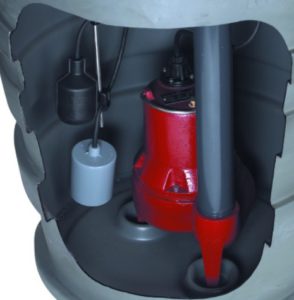 The main differences between the P372LE41 and P372LE51 have to do with pumping speed, maximum head, and reliability. Both are pre-assembled sewage ejection packages, but the 41 has a top speed of 7,680 GPH compared to 8,400 GPH in the 51, and the 41 tops out at 19 feet of head compared to 24 feet in the 51. We’ve also found reliability to be significantly greater in the P372LE51 than in the P372LE41, to the extent that we wouldn’t recommend the 41 if it’s at all possible to purchase the 51 instead. We’re not saying the 41 is unreliable; it’s just not as reliable as the 51 since the core pump within the 41, the LE41A, isn’t as reliable in our observations as the LE51A that powers the P372LE51.
The main differences between the P372LE41 and P372LE51 have to do with pumping speed, maximum head, and reliability. Both are pre-assembled sewage ejection packages, but the 41 has a top speed of 7,680 GPH compared to 8,400 GPH in the 51, and the 41 tops out at 19 feet of head compared to 24 feet in the 51. We’ve also found reliability to be significantly greater in the P372LE51 than in the P372LE41, to the extent that we wouldn’t recommend the 41 if it’s at all possible to purchase the 51 instead. We’re not saying the 41 is unreliable; it’s just not as reliable as the 51 since the core pump within the 41, the LE41A, isn’t as reliable in our observations as the LE51A that powers the P372LE51.
Compared to the PRG101A, the P372LE41 is cheaper, faster, and comes with a sewage basin, which might make one wonder how the PRG101A could be a better investment. It comes down to solids. The PRG101A is the superior sewage pump for any tasks involving processing difficult solids like feminine hygiene products, towels, napkins, or diaper and cleaning wipes because it comes with a grinder. It’s not going to get clogged or stuck by things that shouldn’t be flushed down toilets but that people flushed anyway. If you need top reliability and can’t afford any downtime, you don’t want to try to save a few hundred with the P372LE41; the PRG101A is the pump you need. It also includes a motor more than 2x as strong at 1 hp vs .4 hp and will pump more than 2.5x as high at 50 feet vs 19 feet.
Our Short and Long Term Experiences Installing and Using the Liberty Pumps P372LE41 Sewage Package
Installing the P372LE41 is identical to the process of installing the P372LE51; simply take your time and make sure you either have the relevant experience necessary or know someone who does. A good time estimate for a typical job is somewhere around 7 hours if starting from scratch. In terms of longevity, you can expect a longer working life from the P372LE41 than you’d get from the LE41A due to the reduced cycles inherent in the simplex design. However, that still means a lifetime closer to 10 to 15 years than the up to 20 we’d expect from the P372LE51, and your user experience will naturally vary.
Troubleshooting and Installation Tips to Get Your Liberty Pumps P372LE41 Working Sooner
As is typical with Liberty Pump’s sewage ejector pumps, if you have issues at startup, they’ll typically either be related to the pump not starting, not stopping, or running without pumping.
If your pump doesn’t run, it’s probably due to a power issue, a stuck switch, a lack of sufficient liquid for switch triggering, or a bad switch. If your pump doesn’t stop running, the switch is either stuck or gone bad. If the pump runs but doesn’t pump, it’ll almost always be due to blockage or damage. Either your discharge will be locked or closed, your check valve will be closed or backwards, your ball valve or gate valve will be closed, your pump impeller is jammed, or your volute casing is plugged.
Alternatively, you might simply be needing more head than what your pump can provide. The P372LE51 will get you 5 extra feet while the PRG101A will get you 31 more. As noted above, we’d recommend the PRG101A if you need a lot of head or if you’re dealing with plugging or jamming issues, as that’s exactly what a grinder is built from the ground up to prevent.
Liberty Pumps P372LE41 Simplex Sewage System Pros, Cons, and Value Comparison
In conclusion, while a simplex sewage system is probably the easiest pre-assembled sewage ejector pump system you can find for draining a basement-level toilet, we wouldn’t recommend getting one as the P372LE41 when the P372LE51 costs slightly more and offers much greater reliability. At a basic level, the LE51A pump in the P372LE51 has a better reputation for durability than the LE41A pump in the P372LE41, and when you’re buying a self-contained sewage system, you want all the parts to give as much no-fuss reliability as possible.
That said, the P372LE41 will still provide functionality and years of service if installed in a residential or small business environment where people only flush human waste. That said, if you absolutely need reliability in your home, restaurant, or other small enterprise, and can’t afford to have your drains clogged with things that people shouldn’t flush but flush anyway, you’ll want a grinder-based pump like the PRG101A. Let your clientele, budget, and risk aversion be your guide.
You can buy Liberty Pumps P372LE41 here on Amazon. We’d recommend you instead buy the Liberty Pumps P372LE51 here. You can buy the Liberty Pumps PRG101A here. You can buy a good wet / dry vacuum here. You can buy a silent 2 inch check valve here. You can buy a 2 inch brass ball valve here.
 If you find our work at PumpThatSump helpful, you can put our relentless reviewing of every pump and fixture on the market to the test by shopping via our links above for whatever you need to make your house a home. Despite being self-employed, we promise not to spend it all on health insurance.
If you find our work at PumpThatSump helpful, you can put our relentless reviewing of every pump and fixture on the market to the test by shopping via our links above for whatever you need to make your house a home. Despite being self-employed, we promise not to spend it all on health insurance.
